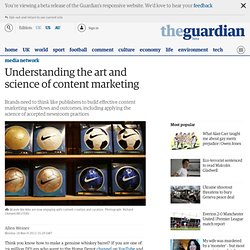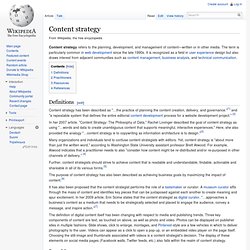

Understanding the art and science of content marketing. Think you know how to make a genuine whiskey barrel?

If you are one of 29 million DIY-ers who went to the Home Depot channel on YouTube and watched a seven-minute clip on that forgotten art, there's a good chance you headed out to your workshop and started hammering away. If Home Depot, whose products and brands are prominently featured in the video, effectively produced its how-to vignette, you headed out to the nearest Home Depot to buy the supplies to become a barrel master. Welcome to the world of content marketing, a practice by which brands and marketers use myriad content forms to craft and communicate their story in ways audience can use and want to share. Beyond the industry conference headlines and industry press, brands and marketers have evolved their social strategy to move content creation and curation to the top of their immediate marketing plans as a means to magnify brand resonance, cultivate evangelists and drive transactions. Who's doing this well? Content + Context Are the New Black. Marko Muellner | March 5, 2013 | 6 Comments inShare25 It's time to dive deep into how digital consumers behave, what they expect, and what engages them.

Content: even the word is complicated for marketers. "Published information"? Sure. A "state of being"? The "highest common factor of a polynomial's coefficient"? And lastly, from the never dull and often NSFW Urban Dictionary: "Buzzword popular in the Internet boom of 1999 that includes everything that takes skill to create; only used by those with no skills. Ouch. Digital marketers have always been content creators and publishers. In recent years, as social media has exploded, the demands on marketers to create and distribute content at scale, constantly, and in a way that delivers real business value have been stretched, too. In a prescient plea penned a year and a half ago for Forbes, Chris Perry, the digital lead at Weber Shandwick asked "Do Organizations Need a Chief Content Officer?
" Enter Steve Rubel. Become a Relevant Filter. The Discovery may have had its last launch with NASA on February 24 of this year. The tech world is just getting started with its own full launch - a love affair complete with predictions, trends, and already a roster of tools and services. Discovery is the new search Actually better. Why? Because it capitalizes on two mechanisms that have long been the domain of strictly physical, if interrelated, experiences: word of mouth commercial transactions It makes sense.
Group buying sites that encourage people to sign up for daily deals, like Groupon and Living Social, have accelerated that trend. You know what's even better than getting one? There's a crop of other, some quite specialized, sites that plan to capitalize on the strong signals and filters currently offered in social networks to help people talk about the items they find, either ask their friends or even perfect strangers how they look with a new outfit, what they should buy, even create public visual displays or carts to share. Online Display Ads: The Brand Awareness Black Hole. Do you have a people strategy? Content Strategy — New York City (New York, NY. Content strategy. Content strategy refers to the planning, development, and management of content—written or in other media.

The term is particularly common in web development since the late 1990s. It is recognized as a field in user experience design but also draws interest from adjacent communities such as content management, business analysis, and technical communication. Definitions[edit] Content strategy has been described as "…the practice of planning the content creation, delivery, and governance. In her 2007 article, "Content Strategy: The Philosophy of Data," Rachel Lovinger described the goal of content strategy as using "…words and data to create unambiguous content that supports meaningful, interactive experiences. " Many organizations and individuals tend to confuse content strategists with editors. It's Not What You Sell, It's What You Believe - Bill Taylor.
By Bill Taylor | 9:14 AM April 4, 2012 Adam Lashinsky’s new book Inside Apple offers lots of intriguing material about Steve Jobs and the strategic choices, design principles, and business tactics that created the most valuable company on earth.

But for all of Lashinsky’s behind-the-scenes material about Apple’s legendary leader, it was a public story about Apple’s new leader, CEO Tim Cook, that captured my attention — and offered a powerful insight for leaders everywhere looking to create value in their organizations. The story goes back to January 21, 2009, during Cook’s inaugural conference call with investors after Jobs announced his medical leave of absence. The very first question, Lashinsky reports, was from an analyst who wanted to know whether Cook might replace Jobs permanently and how the company would be different if he did. Cook did not respond with a detailed review of the products Apple made or the retail environments in which it sold them.